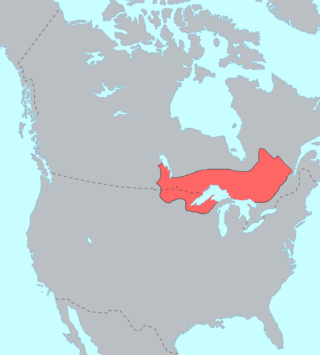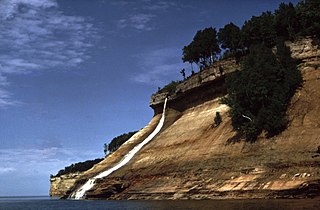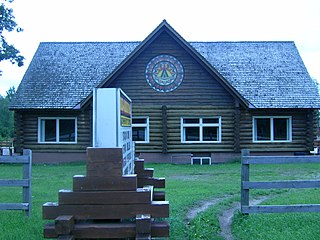
Anishinaabe traditional beliefs cover the traditional belief system of the Anishinaabeg peoples, consisting of the Algonquin/Nipissing, Ojibwa/Chippewa/Saulteaux/Mississaugas, Odawa, Potawatomi and Oji-Cree, located primarily in the Great Lakes region of North America.

The Ojibwe are an Anishinaabe people whose homeland covers much of the Great Lakes region and the northern plains, extending into the subarctic and throughout the northeastern woodlands. The Ojibwe, being Indigenous peoples of the Northeastern Woodlands and of the subarctic, are known by several names, including Ojibway or Chippewa. As a large ethnic group, several distinct nations also consider themselves Ojibwe, including the Saulteaux, Nipissings, and Oji-Cree.

Adolphus Egerton Ryerson was a Canadian educator, author, editor, and Methodist minister who was a prominent contributor to the design of the Canadian public school system. Ryerson is considered to be the founder of the Ontario public school system.

Ojibwe, also known as Ojibwa, Ojibway, Otchipwe, Ojibwemowin, or Anishinaabemowin, is an indigenous language of North America of the Algonquian language family. The language is characterized by a series of dialects that have local names and frequently local writing systems. There is no single dialect that is considered the most prestigious or most prominent, and no standard writing system that covers all dialects.

Pictured Rocks National Lakeshore is a U.S. National Lakeshore in the Upper Peninsula of Michigan, United States. It extends for 42 mi (68 km) along the shore of Lake Superior and covers 73,236 acres. The park has extensive views of the hilly shoreline between Munising and Grand Marais in Alger County, with picturesque rock formations, waterfalls, and sand dunes.

The Anishinaabe are a group of culturally related Indigenous peoples in the Great Lakes region of Canada and the United States. They include the Ojibwe, Odawa, Potawatomi, Mississaugas, Nipissing, and Algonquin peoples. The Anishinaabe speak Anishinaabemowin, or Anishinaabe languages that belong to the Algonquian language family.
Saugeen First Nation is an Ojibway First Nation band located along the Saugeen River and Bruce Peninsula in Ontario, Canada. The band states that their legal name is the "Chippewas of Saugeen". Organized in the mid-1970s, Saugeen First Nation is the primary "political successor apparent" to the Chippewas of Saugeen Ojibway Territory; the other First Nation that is a part of Chippewas of Saugeen Ojibway Territory is Cape Croker. The Ojibway are of the Algonquian languages family. The First Nation consist of four reserves: Chief's Point 28, Saugeen 29, Saugeen Hunting Grounds 60A, and Saugeen and Cape Croker Fishing Islands 1.

Ottawa or Odawa is a dialect of the Ojibwe language spoken by the Odawa people in southern Ontario in Canada, and northern Michigan in the United States. Descendants of migrant Ottawa speakers live in Kansas and Oklahoma. The first recorded meeting of Ottawa speakers and Europeans occurred in 1615 when a party of Ottawas encountered explorer Samuel de Champlain on the north shore of Georgian Bay. Ottawa is written in an alphabetic system using Latin letters, and is known to its speakers as Nishnaabemwin 'speaking the native language' or Daawaamwin 'speaking Ottawa'.

A wiigwaasabak is a birch bark scroll, on which the Ojibwa (Anishinaabe) people of North America wrote with a written language composed of complex geometrical patterns and shapes.

The Walam Olum, Walum Olum or Wallam Olum, usually translated as "Red Record" or "Red Score", is purportedly a historical narrative of the Lenape (Delaware) Native American tribe. The document has provoked controversy as to its authenticity since its publication in the 1830s by botanist and antiquarian Constantine Samuel Rafinesque. Ethnographic studies in the 1980s and analysis in the 1990s of Rafinesque's manuscripts have produced significant evidence that the document may be a hoax.

The Anisininew or Oji-Cree are a First Nation in the Canadian provinces of Ontario and Manitoba, residing in a band extending from the Missinaibi River region in Northeastern Ontario at the east to Lake Winnipeg at the west.

The Severn Ojibwa or the Oji-Cree language is the indigenous name for a dialect of the Ojibwe language spoken in a series of Oji-Cree communities in northern Ontario and at Island Lake, Manitoba, Canada. Ojibwa is a member of the Algonquian language family, itself a member of the Algic language family.

Peter Jones was an Ojibwe Methodist minister, translator, chief and author from Burlington Heights, Upper Canada. His Ojibwa name was Kahkewāquonāby, which means "[Sacred] Waving Feathers". In Mohawk, he was called Desagondensta, meaning "he stands people on their feet". In his youth his band of Mississaugas had been on the verge of destruction. As a preacher and a chieftain, as a role model and as a liaison to governments, his leadership helped his people survive contact with Europeans.

Garden River First Nation, also known as Ketegaunseebee, is an Ojibwa band located at Garden River 14 near Sault Ste. Marie, Ontario, Canada.
The Anishinaabe, like most Algonquian-speaking groups in North America, base their system of kinship on clans or totems. The Ojibwe word for clan was borrowed into English as totem. The clans, based mainly on animals, were instrumental in traditional occupations, intertribal relations, and marriages. Today, the clan remains an important part of Anishinaabe identity. Each clan is forbidden from harming its representation animal by any means, as it is a bad omen to do so.
Chapleau Ojibway First Nation is an Ojibwa First Nation located near Chapleau Township, Sudbury District, Ontario, Canada. The First Nation have reserved for themselves the 67 ha Chapleau 61A Indian Reserve, 64.7 ha Chapleau 74 Indian Reserve and the 799.3 ha Chapleau 74A Indian Reserve. In September, 2007, their total registered population 39, of which their on-reserve population was 30.
John Jones, also known as Thayendanegea in Ojibwe, was a Mississauga Ojibwa teacher, missionary and Chief.

Peter Edmund Jones M.D. was a Mississauga Ojibwa chief of New Credit. In Ojibwe he was called Kahkewaquonaby, named after his father in two languages.
A number of prominent Native Americans have protested against the social and cultural damage inflicted by alcohol on indigenous communities, and have campaigned to raise awareness of the dangers of alcohol and to restrict its availability to Native populations. Initially, these activists resisted the use of rum and brandy as trade items during the colonial era, in an effort to protect Native Americans from cultural changes they viewed as destructive. Later activists framed temperance in terms of Christianity, conforming to the broader temperance movement in the United States. Others led revitalization movements to restore Native American dignity by reverting to traditional customs and ceremonies or attempted to establish alcohol-free communities. During the 1800s several religious movements combined tradition with Christianity to attract a wider following. Modern-day addiction specialists integrate the psychology of substance abuse treatment with traditional rituals and symbolism and with community rehabilitation to reduce stressors and help recovering alcoholics maintain a healthy lifestyle.

George Henry (1811–1888), later Maungwudaus, was an Ojibwe performer, interpreter, mission worker, and herbalist. He interpreted the Ojibwe language into English. He was a herbalist towards the end of his life.














